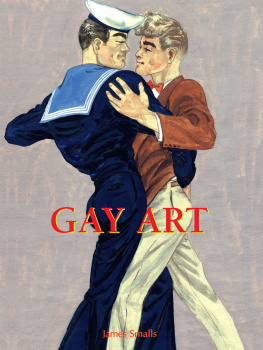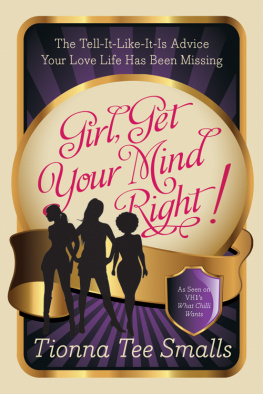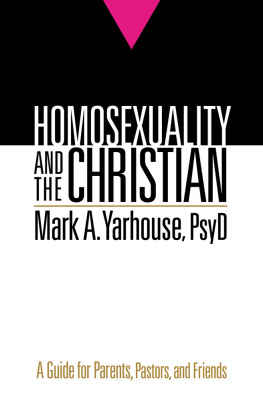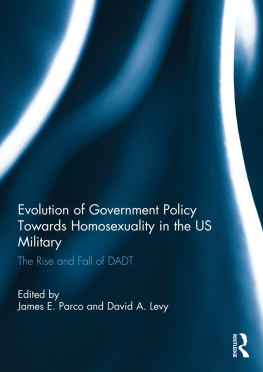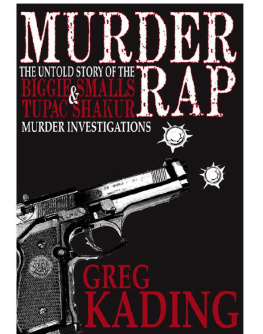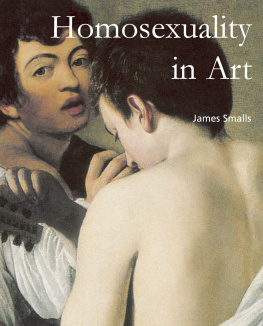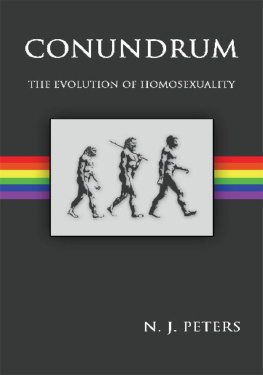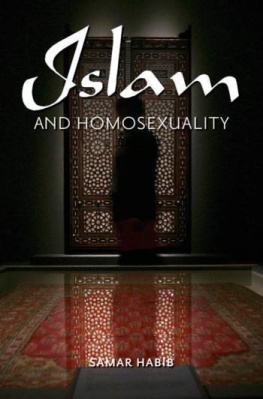Smalls - Gay Art
Here you can read online Smalls - Gay Art full text of the book (entire story) in english for free. Download pdf and epub, get meaning, cover and reviews about this ebook. City: New York, year: 2016, publisher: Parkstone International, genre: Romance novel. Description of the work, (preface) as well as reviews are available. Best literature library LitArk.com created for fans of good reading and offers a wide selection of genres:
Romance novel
Science fiction
Adventure
Detective
Science
History
Home and family
Prose
Art
Politics
Computer
Non-fiction
Religion
Business
Children
Humor
Choose a favorite category and find really read worthwhile books. Enjoy immersion in the world of imagination, feel the emotions of the characters or learn something new for yourself, make an fascinating discovery.
- Book:Gay Art
- Author:
- Publisher:Parkstone International
- Genre:
- Year:2016
- City:New York
- Rating:3 / 5
- Favourites:Add to favourites
- Your mark:
- 60
- 1
- 2
- 3
- 4
- 5
Gay Art: summary, description and annotation
We offer to read an annotation, description, summary or preface (depends on what the author of the book "Gay Art" wrote himself). If you haven't found the necessary information about the book — write in the comments, we will try to find it.
Smalls: author's other books
Who wrote Gay Art? Find out the surname, the name of the author of the book and a list of all author's works by series.
Gay Art — read online for free the complete book (whole text) full work
Below is the text of the book, divided by pages. System saving the place of the last page read, allows you to conveniently read the book "Gay Art" online for free, without having to search again every time where you left off. Put a bookmark, and you can go to the page where you finished reading at any time.
Font size:
Interval:
Bookmark:
Author: James Smalls
BASELINE CO LTD
Baseline Co. Ltd
61A-63A Vo Van Tan Street
4 th Floor
District 3, Ho Chi Minh City
Vietnam
Confidential Concepts, worldwide, USA
Parkstone Press International, New York, USA
Image-Bar www.image-bar.com
Berenice Abbott
Ajamu Ikwe Tyekimba
Francis Bacon Estate, Artists Rights Society (ARS), New York, USA/ DACS, London
Richmond Barth, courtesy Childs Gallery
Mme G. Brassa
Romaine Brooks
Bruce of Los Angeles
Cahun
Centro Elisarion
Tee Corinne
Jean Delville Estate, Artists Rights Society (ARS), New York, USA/ SABAM, Brussels
Charles Demuth
Marcel Duchamp Estate, Artists Rights Society (ARS), New York, USA/ ADAGP, Paris/ Succession Marcel Duchamp
Rotimi Fani-Kayode/Autograph, Association of Black Photographers
Leonor Fini Estate, Artists Rights Society (ARS), New York, USA/ ADAGP, Paris
Wilhelm von Gloeden
Nan Goldin
Duncan Grant, Artists Rights Society (ARS), New York, USA/ DACS, London
Sunil Gupta
George Hare
David Hockney
Holland Day
Art Harmony Hammond/ Licensed by VAGA, New York, NY
Mardsen Hartley, Art Museum, University of Minnesota, Minneapolis
Elisar von Kupffer
Tamara de Lempicka Estate, Artists Rights Society (ARS), New York, USA/ ADAGP, Paris
Herbert List/ Magnum photos
Jeanne-Mammen-Gesellschaft e.V.
Estate Man Ray, Artists Rights Society (ARS), New York, USA/ ADAGP, Paris
Copyright The Robert Mapplethorpe Foundation. Courtesy Art + Commerce
Pierre Molinier Estate, Artists Rights Society (ARS), New York, USA/ ADAGP, Paris
Catherine Opie. Courtesy Regen Projects, Los Angeles
Georg Pauli, Artists Rights Society (ARS), New York, USA/ BUS, Stockholm
Estate of Pablo Picasso, Artists Rights Society (ARS), New York, USA
Kuzma Petrov-Vodkine
Pierre et Gilles. Courtesy Galerie Jrme de Noirmont, Paris
George Platt Lynes
Wilhelm von Plschow
Art George and Helen Segal Foundation / Licensed by VAGA, New York, NY
Smithsonian American Art Museum
Frank Meadow Sutcliffe/ The Sutcliffe Gallery
Tom of Finland 1979 Tom of Finland Foundation 2008 www.TomofFinlandFoundation.org
Tom of Finland 1986 Tom of Finland Foundation 2008 www.TomofFinlandFoundation.org
Andy Warhol Foundation for the Visual Arts, Artists Rights Society (ARS), New York, USA
Minor White
ISBN: 978-1-78525-934-0
All rights reserved.
No part of this book may be reproduced or adapted without the permission of the copyright holder, throughout the world. Unless otherwise specified, copyright on the works reproduced lies with the respective photographers. Despite intensive research, it has not always been possible to establish copyright ownership. Where this is the case, we would appreciate notification.
James Smalls
GAY ART

Contents
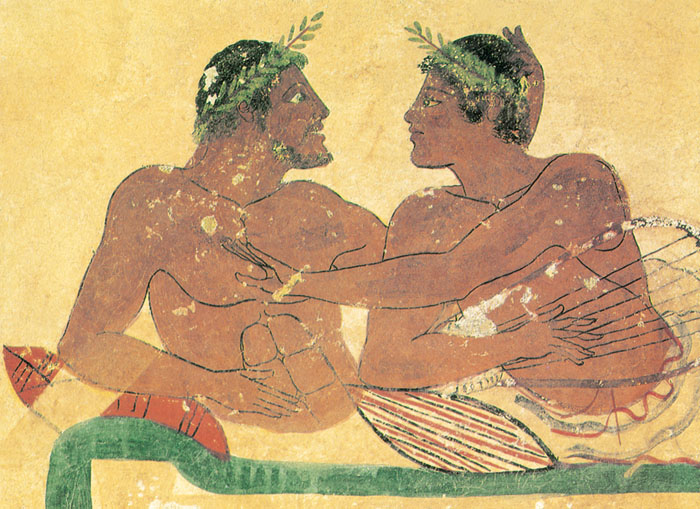
01. Greek painting representing a couple, 480 BC. Museum of Paestum, Italy.
Art and homosexuality may seem like a strange combination, but both phenomena have been part of human history from the beginning of time, or at least from the beginning of recorded civilisation. Bringing together two large concepts art and homosexuality is nevertheless difficult and challenging. Both categories raise a host of conceptual problems and pose a series of unresolved nagging questions.
The primary question, What is art and what purpose does it serve?, has preoccupied humankind for centuries and has yet to find a definitive answer. There exists as many views and definitions about what art is (and is not) and its significance as there are individuals in the world. In the context of Gay Art, I am using the term art in a broad sense as human creation and communication within a visual field. Although the majority of the images here were produced in traditional media such as painting, sculpture, graphics, and photography, art would also include images and forms of production associated with, for example, popular culture, advertising, film, performance, conceptualism, or computer-generated imagery. Ultimately, it is up to the reader of this book to decide what to accept or reject as art.
Unlike art, the other term in this books title, homosexuality, can be defined more specifically. Homosexuality and its emotional aspects have existed in all cultures and in all time periods long before the invention of the term. It is and always has been one aspect of the very complex domain of human sexuality. The way homosexual love and sensibilities are visually expressed is often a reflection of the status of homosexuals themselves within their particular cultures. These images are an indication of either the degree of tolerance in those societies, or the sign of an increasingly restrictive prejudice fostered by traditions and religion.
Before 1869, the words homosexuality and heterosexuality did not exist. The former was coined and first put into use by the German-Hungarian writer and translator Karl Maria Kertbeny (1824-82). He also invented the latter term in 1880. Kertbenys purpose for using the word homosexuality was in response to an article of the Prussian penal code that criminalised sexual relations between men. Kertbeny wanted the article omitted, but was unsuccessful. The code became part of Prussian law in 1871 and was upheld and then strengthened by the Nazis in 1935, and retained by West Germany until 1969 (Haggerty, p.451). Kertbeny had his own specific views on human sexuality. Although there may never have been a coherent theory of homosexuality for him, he did divide homosexuals into specific categories: those who are active, passive, and Platonists, or those who love the company of their own sex without wanting to have sex with them. The designation homosexuality, then, started out as a term of sympathy and political activism to change a repressive law. However, over the years the word evolved into a concept that came to describe an individuals sexual preference. The word and its evolving concept took some time to enter into European languages and thought patterns.
In the 1880s, Kertbenys catchy new term attracted the attention of Richard von Krafft-Ebing, a noted sexologist who used the word in his vastly popular 1886-87 Psychopathia Sexualis, a massive encyclopaedia of sexual deviance. It was through this and subsequent works by noted sexologists of the late nineteenth century that the term homosexuality acquired its medical and clinical connotations. Sexology refers to the study of human sexual behaviour before the codifications of modern psychology and psychoanalysis generated by the thoughts and writings of Sigmund Freud (see Gregory W. Bredbeck, Sexology, in Haggerty, p.794). It was not until the 1950s that homosexuality entered popular English and American usage, largely as a result of the Kinsey reports of 1948. Alfred Kinsey (1894-1956) was an American sex researcher whose scientific data on human sexuality challenged the prevailing notion that homosexuality was a mental illness.
As a concept, homosexuality encompasses a variety of conflicting ideas about gender and same-sex sexual attraction. Its broad range of possible meanings is what makes it such an irresistible, powerful, and ambiguous term nowadays. In its modern sense, homosexuality is at once a psychological condition, an erotic desire, and a sexual practice (David Halperin, Homosexuality, in Haggerty, p.452). All three senses can and are expressed in artistic or aestheticised form. Homosexuality or, to employ a term of more recent invention, the homoerotic, can be understood as an actual or potential element in everyones experience, whatever the sexual orientation of the individual. The homosexual and the homoerotic frequently overlap but are not necessarily the same. Many of the images in this book might be classified as homoerotic rather than homosexual. Homosexual and homoerotic differ only in the root meanings of the terms sexual and erotic. Whereas sexual encompasses the physical act of sex, erotic is a concept that incorporates a range of ideas and feelings around same-sex wants, needs, and desires. It does not always culminate in the sexual act. The homoerotic, unlike the homosexual, legitimates erotic desire between members of the same sex by placing that sentiment in a context which rationalises it such as in classicism, military battle, or athletic activities. Thus, in many situations the homoerotic is veiled and perceived as non-transgressive behaviour. Whereas all homosexuals experience homoerotic desire, not all who experience and, indeed, appreciate homoerotic desire are necessarily homosexuals. The homoerotic can sometimes be a frightening prospect for some heterosexuals to such a degree that it sometimes incites virulent homophobic responses. The homoerotic is also linked to the more recent idea of the homosocial. Male homosociality refers to all-male groups or environments, and is a means by which men construct their identities and consolidate their privilege and social power as males usually through and at the expense of women (see Eve Sedgwick,
Next pageFont size:
Interval:
Bookmark:
Similar books «Gay Art»
Look at similar books to Gay Art. We have selected literature similar in name and meaning in the hope of providing readers with more options to find new, interesting, not yet read works.
Discussion, reviews of the book Gay Art and just readers' own opinions. Leave your comments, write what you think about the work, its meaning or the main characters. Specify what exactly you liked and what you didn't like, and why you think so.

